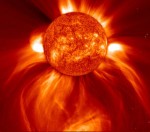8 February 2011 | How Does it Work?, Space |
 This original article was first published in The Dot Connector Magazine, Issue #11.
This original article was first published in The Dot Connector Magazine, Issue #11.
On August 3, 2010, a C3-class solar flare caused a coronal mass ejection that headed towards the Earth. The impact of the flare resulted in a G2-class geomagnetic storm that lasted almost 12 hours. The official story is that the storm caused beautiful northern lights to appear from Europe to North America. Well, that doesn’t seem so bad, does it?
Nevertheless, there has been a lot of talk lately about solar flares and how a big enough solar flare directed towards Earth could knock out electrical grids. As we all know, sometimes the mainstream media talks up certain scenarios to scare everyone. Sometimes they just make things up entirely. In this case, I sat up and took notice because the power in southern Europe was flickering that night. Lights would dim in a pulsating fashion. That is a fairly rare occurrence. It is doubly strange because according to conventional wisdom, geomagnetic storms cause aurorae and electrical problems mostly in latitudes closer to the poles.
Obviously, some investigation was in order. First, we need to understand a little something about sunspots, solar flares, and coronal mass ejections.
(more…)
19 February 2009 | Space |
You may have heard of the recent fender bender in outer space between an Iridium satellite and a “defunct” Russian satellite:
Satellite collision could pose space threat – Crash creates debris; slight risk to space station, minor impact on Iridium
MSNBC.com
12 Feb 2009
Russian and U.S. experts say the first-ever collision between two satellites has created clouds of debris that could threaten other unmanned spacecraft.
Russia’s Mission Control spokesman Valery Lyndin says there is little risk to the international space station with three crew members aboard.
Lyndin said Thursday that officials would monitor the debris from Tuesday’s collision to make sure no fragments get near the station. He said the station’s orbit was adjusted in the past to avoid debris.
Other Russian and U.S. officials warn that satellites in nearby orbits could be damaged.
The smashup occured over Siberia when a derelict Russian military communications satellite crossed paths with a U.S. Iridium satellite.
The two big communications satellites collided in the first-ever crash of two intact spacecraft in orbit, shooting out a pair of massive debris clouds and posing a slight risk to the international space station.
NASA said it will take weeks to determine the full magnitude of the crash, which occurred nearly 500 miles (800 kilometers) over Siberia on Tuesday.
Okay, so let’s think about this, because I don’t buy it. Why not?
(more…)
 This original article was first published in The Dot Connector Magazine, Issue #11.
This original article was first published in The Dot Connector Magazine, Issue #11.

Recent Comments